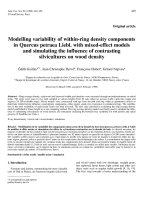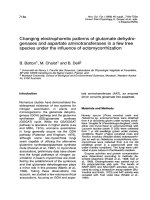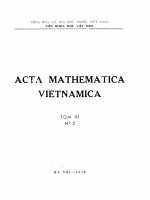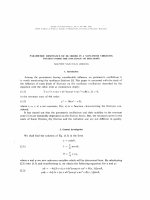The ettingshausen effect in doped semiconductor superlattice under the influence of confined optical phonon
Bạn đang xem bản rút gọn của tài liệu. Xem và tải ngay bản đầy đủ của tài liệu tại đây (571.2 KB, 8 trang )
VNU Journal of Science: Mathematics – Physics, Vol. 36, No. 3 (2020) 39-46
Original Article
The Ettingshausen Effect in Doped Semiconductor
Superlattice under the Influence of Confined Optical Phonon
Cao Thi Vi Ba, Nguyen Thi Lam Quynh*, Nguyen Quang Bau
VNU University of Science, 334 Nguyen Trai, Thanh Xuan, Hanoi, Vietnam
Received 18 December 2019
Revised 30 March 2020; Accepted 15 April 2020
Abstract. The electron – optical phonon scattering is considered in detail to studying the
Ettingshausen effect in doped semiconductor superlattice under the influence of phonon
confinement and laser radiation. The analytical expressions for tensors and the Ettingshausen
coefficient are obtained by using the kinetic equation method. The Ettingshausen coefficient
depends on temperature of the sample, amplitude and frequency of laser radiation, magnetic field
and the quantum number m specific for the confinement of phonon. The dependences are clearly
displayed in the numerical results for GaAs:Be/GaAs:Si doped semiconductor superlattice. The
magnetic field makes the Ettingshausen coefficient change in quantitative under the influence of
temperature or laser amplitude and change the resonance condition. The numerical results show that
both resonance condition and resonance peaks position are affected by the increase of quantum
number m. We also get the result corresponding to the unconfined optical phonon case when m is
set to zero. Due to the change of the wave function and energy spectrum of electrons, most of results
for the Ettingshausen effect in doped semiconductor superlattice obtained are different from the case
of bulk semiconductor. Moreover, in comparison with the case of unconfined optical phonon, under
the influence of phonon confinement effect, the Ettingshausen coefficient changes in magnitude, the
number and position of resonance peaks.
Keywords: Doped semiconductor superlattice, Ettingshausen effect, Quantum kinetic equation,
confined optical phonons.
1. Introduction
It’s well known that the confinement of electron as well as phonon is the main cause of changes in
the properties of kinetic effects in two-dimensional semiconductor systems (2DS) and doped
________
Corresponding author.
Email address:
https//doi.org/ 10.25073/2588-1124/vnumap.4449
39
40
C.T.V. Ba et al. / VNU Journal of Science: Mathematics – Physics, Vol. 36, No. 3 (2020) 39-46
semiconductor superlattice (DSS) in particular. Many papers dealing with this issue have been published
[1-3]. Due to the emission of confined longitudinal optical (LO) phonon in GaAs-Al0.45Ga0.55As
superlattice, the dispersion of the relaxation time depends strongly on the total energy [1]. The electron
– phonon scattering strength is strongly influenced by the polar optical phonon confinement in
quantum well [2]. In comparison with the case of bulk phonons, due to the confinement of LO phonon in doped semiconductor superlattices, the magnitude of magnetoresistance and the Hall
coefficient are decreased [3].
The Ettingshausen effect is known as an unexpected result when Ettingshausen and his PhD student
studied Hall effect in Bismuth. That has opened up a new field of research on magneto-thermoelectric
phenomena. This effect has been studied in various materials such as metals [4], graphene [5], bulk
semiconductor [6] and especially low-dimensional semiconductor systems (LDS) [7-11]. In parabolic
quantum well with in-plane magnetic field, Ettingshausen effect change sign with temperature even if
the mechanism of scattering remains unchanged [7]. Due to the influence of the dimension effects and
laser radiation (LR), the Ettingshausen coefficient (EC) in quantum well is 102 times bigger than that in
bulk semiconductor [8]. When the magnetic field increases, the curve representing the dependence of
longitudinal magneto-thermoelectric coefficient on two-dimensional concentration in a quantum well
shifts downwards [9]. The oscillations of absorbed microwave power due to Landau quantization causes
the appearance of a peak of the longitudinal diffusive thermopower in quantum wells at cyclotron
absorption frequency modified by heating mechanism [10]. The Shubnikov-de Haas oscillation
appeared when surveying the dependence of EC on the magnetic field in DSS [11]. However, Ref. [711] have not taken interested in the confinement of phonon. So, the Ettingshausen effect in DSS under
the influence of confined phonon is opened to study.
In this work, the influence of LR is taken into account for the Ettingshausen effect in DSS and the
confined electron – confined optical phonon (COP) scattering is considered in detail. This article is
organized as follows: the effect of COP on the EC in DSS is outlined in Sec.2; the numerical results and
discussion for GaAs:Be/GaAs:Si DSS are given by Sec.3; Sec.4 shows conclusions.
2. The Calculation of EC in DSS
We apply the quantum kinetic equation method to study the Ettingshausen effect in a simple model
of DSS in which the electron can move freely in the x-y plane. A magnetic field with B 0,0, B , a dc
electric field with E1 E1 ,0,0 and the LR E E0 sin t were applied for our model [3]. From
Hamiltonian of electron - COP system in DSS, the quantum kinetic equation for electrons is obtained.
After some analytic transformations, we found out the expression for the Ettingshausen coefficient:
EC
σ xx m φxy m σ xy m φxx m
1
H σ xx m θxx m φxx m σ xx m αxx m K L
(1)
In which σ xx m , φxy m , θ xx , αxx m are respectively components of tensors:
ip m a
e F
1 c 2 2 F
kp 01
e
A1 m A3 m 13 13 A2 m A4 m 24 24
me
(2)
A5 m 5 5 A6 m 6 6 A7 m 7 7 A8 m 8 8
C.T.V. Ba et al. / VNU Journal of Science: Mathematics – Physics, Vol. 36, No. 3 (2020) 39-46
ip m
41
1
A1 m A3 m m 13 13 A2 m A4 m m 24 24
meT
A5 m m 5 5 A6 m m 6 6
A7 m m 7 7 A8 m m 8 8
(3)
1
A1 m A3 m m 13 13 A2 m A4 m m 24 24
me
ip m
A5 m m 5 5 A6 m m 6 6
(4)
A7 m m 7 7 A8 m m 8 8
ip m
1
2
2
A1 m A3 m m 13 13 A2 m A4 m m 24 24
emeT
A5 m m 5 5 A6 m m 6 6
2
2
A7 m m 7 7 A8 m m 8 8
2
Where: a
2
(5)
e vd n0
I p y e F N ,n ;
me
N ,n
As m A m
I
m
n,n '
N ', n ', m N , n
eE1 F N ,n
l e
I p y I q Nn eE1 l m s 1,2
vd
3
eE
As m A m I nm,n ' 1 l e F N ,n I p y I q Nn eE1 l m s 3,4
2 N ',n ',m N ,n
vd
3
eE
As m A m I nm,n ' 1 l e F N ,n I p y I q Nn eE1 l m s 5 8
4 N ',n ',m N ,n
vd
with definition:
1
1 l
l N N 1 B [3]; F is the Fermi level; is the momentum
2
22
relaxation time.
A m
1
4 2 e3 m n0
1
1
; Nn N ' N c n ' n p
m
0 me
e
1 0
1
1
1
2
m o 2 vs 2 m / L ; N ,n N c n p mvd 2
2
2
2
I py
1
eE
0
F ; I q
2 ;
2 N ,n
2 lB
vd
me
Ly
2
2
42
v m
C.T.V. Ba et al. / VNU Journal of Science: Mathematics – Physics, Vol. 36, No. 3 (2020) 39-46
2 F m
1 c 2 2 F m
2
v 1 4 ; v m
2 F m
1 c 2 2 F m
2
v 5 8
u ik c v ijk hj c 2 2 hi kk kp c v klp hl c 2 2 hk k p u, v 1 8
Here: ik is the Kronecker delta; the Latin symbols i, j, k , l , p stand for the components x, y, z of the
Cartesian coordinates;
klp
is the anti-symmetrical Levi - Civita tensor;
c
eB
me
and
2
4 e2 nD
p
are cyclotron frequency and plasma frequency, respectively (nD is the doping
0 me
concentration of the DSS).
From above analytic expression, we can see clearly that the EC depends on many quantities such as
amplitude and frequency of the LR, the magnetic induction, the temperature. Especially, the EC depend
in complicated way on the m-quantum number specific for COP. We also obtained the expression that
corresponds to un-COP when m is set to zero.
3. Numerical Results and Discussion
We have considered a GaAs:Be/GaAs:Si DSS with characteristic parameters: me = 0.067m0,
e=2.07e0, vs = 87300ms−1, εF = 50eV, τ (εF) = 10−12s [3], N = 1, N’ = 3; n and n’ rate from 1 to 3.
(1a)
(1b)
Figure 1. The denpendence of the EC on the temperture.
According to Figure 1, the EC exerts non-linear dependence on temperature. Figure (1a) shows that
the phonon confinement reduces the EC in DSS. The difference between two cases (with and without
phonon confinement) is obvious at high temperature. As we see in Figure (1b), the magnetic field also
affects the EC in temperature range surveyed when optical phonons are confined. The EC increases
C.T.V. Ba et al. / VNU Journal of Science: Mathematics – Physics, Vol. 36, No. 3 (2020) 39-46
43
when the magnetic induction increases. However, the magnetic field does not change the rule of the
EC’s dependence on temperature.
(2a)
(2b)
Figure 2. The dependence of the EC on the laser frequency.
As we can see in Figure 2, the EC oscillates when the laser frequency changes. Figure (2a) describes
the dependence of EC on laser frequency in two cases: with and without confinement of optical phonons.
In COP case, the EC not only increases in quantitative but also enhances the number of resonance peaks.
n n ' p eE1 l m 2 c or
The resonance peaks correspond to the condition:
n ' n p eE1 l
m 2 c with m o 2 vs 2 m / L . When m is set to zero, the
2
frequency of optical phonon is defined m 0 . The increase of m leads to the increase of m and
make resonance condition change. So, the additional resonance peaks are appeared. Therefore, the
confinement of optical phonon not only makes the EC in DSS increase but also causes the appearance
of new resonance peaks. It also means that the results for the EC in DSS obtained is different from the
case of bulk semiconductor [6].
Figure (2b) shows that the magnetic induction significant impact on locating the resonance peaks.
eB
It is so easy to explain. c
absent in the expression to identify resonance frequency of laser
me
radiation mentioned above. Therefore, the change of magnetic field leads to change of resonance
condition. In the case of phonon confinement, the EC has negative values when the magnetic field is
strong.
Figure 3 indicates the influence of laser amplitude on the EC. The bigger laser amplitude increases,
the bigger EC gets. The EC increases fast when laser amplitude is greater than 4.10 5 Vm-1. Similar to
the dependence of the EC on temperature, due to the confinement of optical phonon, the value of EC
decreases in comparison with un-COP case. In the low laser amplitude condition (less than 2.105 Vm-1)
the EC is almost unchanged and approaches to zero when the laser amplitude increases. Besides, the EC
44
C.T.V. Ba et al. / VNU Journal of Science: Mathematics – Physics, Vol. 36, No. 3 (2020) 39-46
has positive values with COP and even un-COP. Furthermore, when the magnetic field increases, the
EC decreases. That is displayed explicitly by Figure (3b).
(3a)
(3b)
Figure 3. The dependence of the EC on the laser amplitude.
Figure 4. The dependence of the EC on the magnetic field.
Figure 4 shows the EC plotted as a function of magnetic induction at different values of quantum
number m. Due to the phonon confinement, the EC changes resonance peaks position. The resonance
n n ' p eE1 l m
peaks position is determined by condition: B me
. For simply, eE1 l can
2e
C.T.V. Ba et al. / VNU Journal of Science: Mathematics – Physics, Vol. 36, No. 3 (2020) 39-46
be neglected ( eE1 l
45
0 ). When optical phonons are confined, their energy and wave vector are
quantized. The COP frequency is defined:
m o 2 vs 2 m / L . Each value of m determines a
2
value of COP frequency. So, the increase of quantum number m affects resonant condition.
4. Conclusions
Based on the kinetic equation method, we have studied the influence of COP on the Ettingshausen
effect in GaAs:Si/GaAs:Be DSS. Due to the remarkable contribution of COP and size effect, the
theoretical results for Ettingshausen effect in DSS are different from the previous one [6]. The results
are derived from the change of wave vector and energy spectrum of electrons in DSS in comparison
with bulk semiconductor. Under the influence of phonon confinement effect, the Ettingshausen
coefficient changes in magnitude, the number and position of resonance peaks in comparison with unCOP case. Because of the increase of phonon confinement effect, the resonance condition in DSS
changes and the EC decreases. The increase of magnetic field leads to the increase of the EC when
temperature increases. It is contrary to the result obtained when investigating the dependence of the EC
on the laser amplitude. We also get the results fitting to the un-COP case when the quantum number is
set to zero. So far, the results obtained are new for Ettingshausen effects in DSS and contribute to the
research and making new semiconductor materials.
Acknowledgments
This research is funded by the VNU University of Science under project number TN. 19.03.
References
[1] D. Abouelaoualim, Electron–confined LO-phonon scattering in GaAs-Al0.45Ga0.55As superlattice, Pramana Journal
of Physics 66 (2006) 455-465. />[2] J. Pozela, A. Namajunas, K. Pozela, V. Juciene, Electrons and phonons in quantum wells, Semiconductor 33 (1999)
956 -960. />[3] N.Q. Bau, D.T. Long, Impact of confined LO-phonons on the Hall effect in doped semiconductor superlattices,
Journal of Science: Advanced Materials and Devices 1 (2016) 209-213.
/>[4] J.C.G. de Sande, J.M. Guerra, Nernst-Ettingshausen effect in polycrystalline bismuth at high temperature, Phy.
Rev. B. 45 (1992) 11469-11473. />[5] Z.Z. Alisultanov, Nernst-Ettingshausen effect in graphene, JETP Letters. 99 (2014) 702-705.
/>[6] B.V. Paranjape, J.S. Levinger, Theory of the Ettingshausen effect in semiconductors, Phys. Rev. 120 (1960) 437441. />[7] F.M. Hashimzade, M.M. Babayev, B.H. Mehdiyev, K.A. Hasanov, Magneto-thermoelectric Effects of 2D Electron
Gas in Quantum Well with Parabolic Confinement Potential in-plane Magnetic Field, Journal of Physics:
Conference Series 245 (2010) 012015-012019. />[8] D.T. Hang, D.T. Ha, D.T.T. Thanh, N.Q. Bau, The Ettingshausen coefficient in quantum wells under the influence
of laser radiation in the case of electron-optical phonon interaction, Photonics Letters of Poland 8 (2016) 79-81.
/>
46
C.T.V. Ba et al. / VNU Journal of Science: Mathematics – Physics, Vol. 36, No. 3 (2020) 39-46
[9] F.M. Hashimzade, Kh.A. Hasanov, B.H. Mehdiyev, S. Cakmak, Magneto –thermoelectric effects in twodimensional quantum well: role of short-range potential, Phys. Scr. 81 (2010) 1-8. />[10] O. E. Raichev, Theory of magnetothermoelectric phenomena in high-mobility two-dimensional electron systems
under microwave irradiation, Phys. Rev. B. 91 (2015) 235307-235323.
/>[11] D.T.T. Hang, N.V. Nhan, N.Q. Bau, Theoretical Study of the Magneto-Thermoelectric Effect in Doped
Semiconductor Superlattices under the Influence of an Electromagnetic Wave by Using a Quantum Kinetic
Equation, Key Engineering Materials. 783 (2018) 93-102.
/>









